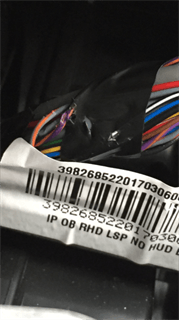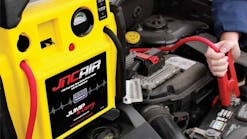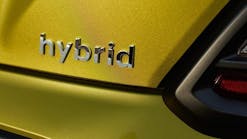Mid speed CAN bus failure on a Volvo XC60
This 2017 Volvo XC60 with a 2-liter engine had multiple electrical failures reported by the owner. These were all relating to the Body electrical system. The faults were intermittent in nature. When the issue was present, the following sub-systems failed to operate:
- Remote Keyless Entry.
- Instrument Panel.
- Electronic Climate Control.
- Infotainment system.
- Central Locking.
- Electric Windows.
- Power Mirrors.
- Directional Indicators.
- Power Tailgate.
The vehicle would start and operate as expected even with the issue present. A scan tool was connected to the vehicle’s Data Link Connector (DLC) and numerous fault codes were stored. The following codes were found with a full system Code Scan:
| Module | Fault Code ID | Fault Code Title |
| Central Electronic Module | U015500 | Lost Communication with Driver Information Module |
| Central Electronic Module | U016400 | Lost Communication with Climate Control Module |
| Central Electronic Module | U019900 | Lost Communication with Driver Door Module |
| Central Electronic Module | U020000 | Lost Communication with Passenger Door Module |
| Central Electronic Module | U001011 | Medium Speed CAN Bus - Short to Ground |
| Central Electronic Module | U001088 | Medium Speed CAN Bus – Bus Off |
| Central Electronic Module | U021400 | Lost Communication with Keyless Vehicle Module |
| Central Electronic Module | U023000 | Lost Communication with Power Tailgate Module |
| Supplementary Restraint Module | U015500 | Lost Communication with Driver Information Module |
| Driver Information Module | U001088 | Medium Speed CAN Bus – Bus Off |
| Driver Information Module | U210000 | Control Module Unconfigured |
| Driver Door Module | U001000 | Medium Speed CAN Bus – General Fault |
| Driver Door Module | U014000 | Lost Communication with Central Electronic Module |
| Driver Door Module | U016487 | Lost Communication with Climate Control module |
| Passenger Door Module | U001000 | Medium Speed CAN Bus – General Fault |
| Passenger Door Module | U014000 | Lost Communication with Central Electronic Module |
| Passenger Door Module | U016487 | Lost Communication with Climate Control module |
| Climate Control Module | U001088 | Medium Speed CAN Bus – Bus Off |
| Climate Control Module | U014000 | Lost Communication with Central Electronic Module |
| Infotainment Control Module | U001000 | Medium Speed CAN Bus – General Fault |
| Keyless Vehicle Module | U001000 | Medium Speed CAN Bus – General Fault |
| Power Operated Tailgate | U001000 | Medium Speed CAN Bus – General Fault |
| Power Operated Tailgate | U210000 | Control Module Unconfigured |
A wiring diagram was consulted to investigate the modules thst communicate on the Medium Speed data bus. The diagram below is simplified to show the modules on the Mid Speed network.
CEM – Central Electronic Module.
CCM – Climate Control module.
ICM – Infotainment Control Module.
DIM – Driver Information module.
DDM – Driver Door Module.
PDM – Passenger Door Module.
KVM – Keyless Vehicle Module.
POT – Power Operated Tailgate.
It can also be seen from the diagram that pin 3 and 11 at the Data Link Connector (DLC) are connected to the Medium Speed CAN Bus. This is a very convenient point to test the network. A 16 pin break-out box can be used to allow easy access to the DLC pins.
An oscilloscope was connected to the breakout box and the following waveform was observed when the faults were present.
- Yellow Channel – Pin 3.
- Green Channel – Pin 11.
It can be seen from this waveform that there is no activity on the network and the voltage is close to ground potential.
This issue can occur due to a module internally shorting the network to ground or a wiring fault creating the short circuit. One of the more common areas on a vehicle for wiring problems is the wiring loom where it enters the doors. As faults were present in both the Driver and Passenger Door Modules this was the first area to be investigated. The wiring to both the driver and passenger door was undamaged and disconnecting one door at a time did not resolve the issue.
Another common failure on modern vehicles is the instrument cluster. On this particular vehicle, the cluster is relatively easy to remove and disconnect the electrical connector. No issue was found here and with the module disconnected, the network did not become active.
The next part of the network to investigate, was the Climate Control Module. It was noticed that the CAN signal was intermittently present while the CCM was being removed from the dash. Applying hand pressure to the dashboard resolved the issue, removing the hand from the dash resulted in the fault re-appearing. This is indicative of a wiring fault and in particular a wire(s) shorting against a vehicle ground. The CCM, glovebox, radio and various trim panels were removed to inspect the wiring.
One of the Mid Speed CAN Bus network wires was found to be touching a metal bracket behind the radio.
The wiring was repaired and a foam pad attached to the metal bracket for additional protection against future issues.
The CAN network now preformed as expected.
Mid Speed CAN Bus data signal
Data Transfer Speed calculated from End of Frame Bit (EOF) – 125 Kbits per Second.
Differential Voltage between CAN High and Low – Mid Speed CAN Bus Network.
The fault codes were erased and the vehicle reassembled. A Road test was carried out and the vehicle preformed as expected. This repair would have been very difficult without the correct wiring diagram for the vehicle, a scan tool to access the fault codes in each system and an oscilloscope to monitor the CAN bus signal.



